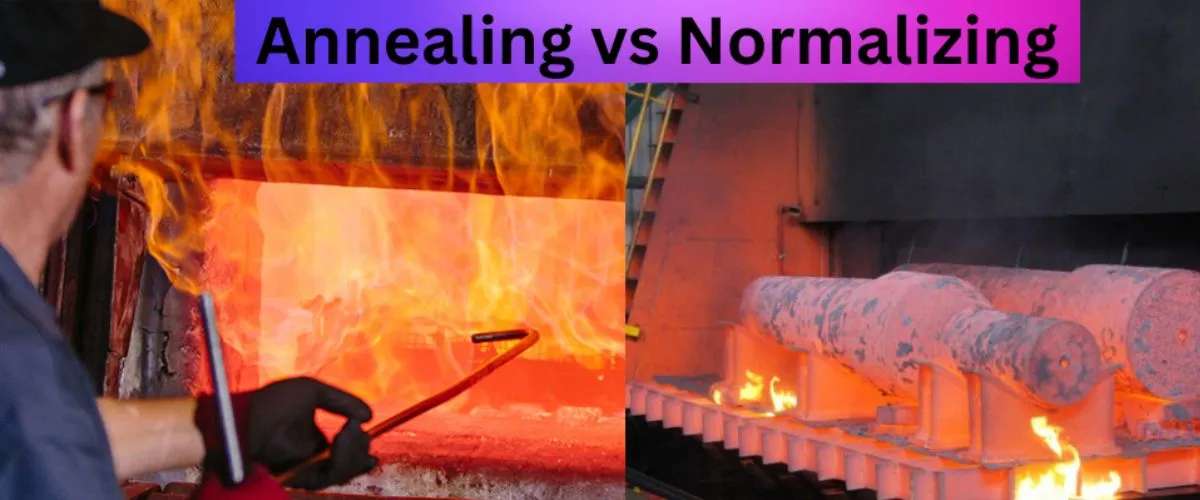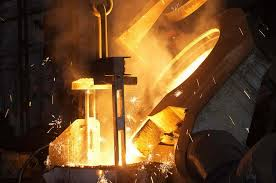Metal Normalizing[+Practical Tables]
![Metal Normalizing[+Practical Tables]](https://ufc-dtc-cms.oss-accelerate.aliyuncs.com/blog/20250821/162308_pdjcx27rr.png)
Learn what metal normalizing is, how the heat treatment process works, its benefits compared to annealing and quenching, and which materials are suitable.
Introduction
Metal parts must endure heavy loads, thermal cycles, and tight tolerances without failure. Without proper heat treatment, steels can warp, crack, or wear prematurely. Metal normalizing is one of the most reliable methods to achieve stable, predictable properties at a competitive cost.
Unlike quenching, normalizing is a production-friendly process that requires no quench tanks, making it suitable for both batch and continuous operations. It delivers a balance of hardness, toughness, and machinability—often superior to simple annealing.
For engineers and buyers, the key value is repeatability and consistency across sections and geometries, reducing rework, scrap, and tool wear.
What is Metal Normalizing?
Metal normalizing is a heat treatment process where steel is heated above its upper critical temperature, held to achieve full transformation, and then air-cooled. This results in a fine ferrite–pearlite structure that provides:
Improved machinability
Increased toughness
Better dimensional stability
Typical normalizing temperature ranges between 815–925°C, with soak times depending on section thickness. During the process, steel first transforms into austenite; controlled air cooling then reforms ferrite and pearlite, refining grains and reducing brittleness from prior processing such as forging, casting, or welding.
Key Process Steps
The normalizing process follows a structured sequence that ensures consistency in microstructure and mechanical properties:
Step | Description | Key Notes |
|---|---|---|
Heating | Heat the steel uniformly to ~40–50°C above Ac3 (or Ac1 for hypereutectoid steels). | Use controlled ramp rates to avoid thermal shock; apply protective coatings to prevent decarburization. |
Soaking | Hold at temperature until complete transformation into austenite. Common rule: 1 hour per 25 mm thickness. | Avoid over-soaking to prevent grain coarsening, which lowers toughness. |
Cooling | Cool in still air, ensuring sufficient spacing for airflow. Vertical orientation minimizes distortion. | Fan-assisted air may be used for tighter hardness control. |
In addition to the main stages, distortion control and quality verification are crucial. Fixtures should support parts at neutral points to minimize stress, while hardness testing and metallographic analysis confirm proper transformation.
If you already have a CAD model ready, try Unionfab’s free Cost Calculator to estimate your project’s heat treatment expenses instantly.
Types of Normalizing
Normalizing is not a one-size-fits-all process. Different variations are designed for specific industrial needs, as shown below:
Type | Method | Application | Key Advantage |
|---|---|---|---|
Full Normalizing | Heat above Ac3, followed by air cooling. | Forgings, castings, welded structures. | Produces fine ferrite–pearlite with balanced strength and toughness. |
Isothermal Normalizing | Austenitize, then hold at 600–700°C before cooling. | Thick sections, aerospace, pressure parts. | Ensures uniform properties across complex geometries. |
Process Normalizing | Uses accelerated cooling (air blast or mist). | Medium-strength steels requiring higher hardness. | Increases hardness while avoiding quench distortion. |
Sub-Critical Normalizing | Heat below Ac1 without phase transformation. | Welded or heavily machined parts. | Relieves stress and stabilizes structure. |
Double Normalizing | Two heating–cooling cycles. | Heavy castings with coarse microstructure. | Refines grains and improves fatigue resistance. |
When to Choose Different Normalizing Types
Choose Full Normalizing when you need a general-purpose treatment for forgings, castings, and welded structures. It is the most common choice for achieving balanced strength and toughness.
Choose Isothermal Normalizing if you are dealing with thick cross-sections or complex aerospace/pressure components, where uniform properties throughout the section are critical.
Choose Process Normalizing when higher hardness is required but quenching distortion must be avoided. This is often suitable for medium-strength steels in automotive and mechanical parts.
Choose Sub-Critical Normalizing for welded or heavily machined components that need stress relief but not a full phase transformation. It is an economical choice for stabilizing geometry.
Choose Double Normalizing for large castings or steels with coarse grain structures, where additional refinement and toughness are needed, especially in fatigue-critical applications.
Suitable Materials
Not all metals respond equally well to normalizing. The process is most effective for steels and ferrous alloys, while non-ferrous alloys require other treatments.
Material Suitability
Normalizing is particularly beneficial for the following materials:
Low Carbon Steels (0.05–0.30% C): Improves machinability, reduces residual stresses, commonly used in automotive and construction parts.
Medium Carbon Steels (0.30–0.60% C): Enhances toughness and prepares steel for surface treatments such as carburizing or nitriding.
Low-Alloy Steels (with Cr, Mo, Ni): Provides impact resistance when precisely controlled; widely used in aerospace and heavy machinery.
Tool Steels (pre-hardening): Ensures a uniform base for further hardening and wear resistance.
Cast Irons (ductile and malleable): Reduces brittleness and stabilizes large sections.
Welded Structures: Relieves stresses in the heat-affected zone and improves fatigue resistance.
Material Type | Suitability for Normalizing | Typical Applications | Alternative/Additional Treatments |
|---|---|---|---|
Low Carbon Steels | Excellent – improves machinability and dimensional stability | Automotive frames, housings, structural parts | Carburizing, case hardening |
Medium Carbon Steels | Very good – balances hardness and toughness | Shafts, gears, axles, pressure parts | Quenching + tempering |
Low-Alloy Steels (Cr-Mo) | Good – requires precise cycle control for impact performance | Aerospace, energy, machinery parts | Quench & temper, stress relieving |
Tool Steels (before hardening) | Excellent preparatory treatment | Cutting tools, molds, dies | Hardening + tempering |
Cast Irons | Useful for stabilizing thick sections | Pump housings, machine bases | Stress relieving, annealing |
Welded Structures | Highly effective for relieving stresses | Bridges, frames, heavy fabrications | Post-weld heat treatment (PWHT) |
Materials to Avoid
Certain metals and alloys should not be normalized because they do not benefit from this process:
Aluminum Alloys: Require solution treatment and aging.
Copper Alloys (brass, bronze): Better suited to precipitation hardening or annealing.
Titanium Alloys: Respond best to solution treatment and aging.
High-Alloy Steels (e.g., austenitic stainless steels): Retain an austenitic structure; more suitable for solution annealing.
Material Type | Suitability for Normalizing | Reason Not Suitable | Alternative Treatments |
|---|---|---|---|
Aluminum Alloys | Not suitable | No ferrite–pearlite structure | Solution heat treatment + aging |
Copper Alloys (Brass, Bronze) | Not suitable | No critical transformation temperature | Precipitation hardening, stress relieving |
Titanium Alloys | Not suitable | Require specific phase control | Solution treatment, aging |
High-Alloy Steels (e.g., austenitic stainless) | Not suitable | Austenitic structure not refined by normalizing | Solution annealing, aging |
Looking for expert advice on whether your material is suitable? Talk to Unionfab Experts for professional guidance.
Normalizing vs Annealing

Source:tprototype.com
Normalizing and annealing are two of the most common heat treatment methods for steels, but they deliver different outcomes. Choosing between them depends on whether the priority is strength, machinability, or maximum ductility.
Performance Metric | Normalizing (Air Cooling) | Annealing (Slow Furnace Cooling) |
|---|---|---|
Hardness | Higher; offers a harder final structure | Lower; softer and more ductile |
Tensile Strength & Toughness | Elevated—balanced strength and impact resistance | Lower tensile strength, but higher ductility |
Grain Structure | Finer, more uniform ferrite–pearlite grains | Coarser grains with larger ferrite–pearlite |
Internal Stress Relief | Moderate—some stress relief, grain refinement | Excellent—maximizes stress relief |
Dimensional Stability | Good—moderate distortion, faster cool | Excellent—minimal distortion, best for complex parts |
Process Time & Cost | Faster and generally more cost-effective | Longer cycle, higher energy and furnace cost |
Best Use Cases | When moderate hardness and toughness are needed efficiently | When maximum ductility or softening is required |
When to Choose Normalizing vs Annealing:
Choose normalizing if you need higher hardness, balanced strength, and machinability for parts such as shafts, gears, and housings.
Choose annealing if you require maximum softness and stress relief for easier machining or forming, often used before cold working.
For a more detailed comparison of these two heat treatments, see Unionfab’s dedicated guide:
Annealing vs. Normalizing: Contrasts, Benefits, and Applications
Benefits and Reasons to Choose Normalizing
Normalizing is widely adopted because it combines technical performance advantages with business and manufacturing value. It provides a balance of hardness, toughness, and machinability, while also delivering cost savings and reliability.

Source: wasatchsteel.com
Key Benefits of Normalizing
Mechanical Performance:
Grain refinement improves tensile strength, yield strength, and impact toughness.
Uniform microstructure reduces fatigue scatter, extending component service life.
Dimensional Stability:
Air cooling minimizes distortion compared to quenching.
Produces stable stock for machining and further surface treatments.
Cost and Efficiency:
Faster cycles than annealing reduce processing time.
Lower scrap rates and reduced tooling wear cut manufacturing costs.
Process Reliability:
No quench tanks required, reducing equipment maintenance and process variability.
Easy to scale for both batch and continuous production.
Business and Application Value
Balanced Properties: Makes normalizing suitable for gears, shafts, housings, flanges, and welded frames where moderate hardness and toughness are needed.
Manufacturing Advantages: Predictable machinability reduces tool wear, improves throughput, and lowers total cost of ownership.
Supply Chain Simplification: Eliminates special quench media, reducing logistical complexity and environmental impact.
Standards Compliance: Furnace charts, hardness maps, and metallographic reports make it easy to meet industry quality requirements.
Business Impact:
Reduced rejects and rework
Shorter production lead times
Consistent performance across multiple components and batches
Benefit/Reason | Description | Impact on Manufacturing/Business |
|---|---|---|
Mechanical Performance | Fine grains increase strength and toughness | More reliable and durable parts |
Dimensional Stability | Air cooling prevents major distortion | Precision machining with less rework |
Cost & Efficiency | Faster cycles, lower scrap, less tool wear | Lower production cost and faster throughput |
Process Reliability | Eliminates quench tanks, reduces variability | Stable quality across production lines |
Balanced Properties | Good mix of hardness, toughness, machinability | Ideal for shafts, gears, and welded frames |
Compliance & Standards | Easy documentation of heat treatment | Meets industrial specifications |
Interested in applying normalizing to your steel parts? [Upload Your 3D File] to Unionfab and get an instant cost estimate for your project.
Conclusion
Metal normalizing is an essential heat treatment process that refines grain structure, enhances toughness, and improves machinability while minimizing distortion. It provides an economical and environmentally friendly alternative to annealing and quenching, making it a cornerstone for many steel manufacturing applications.
Unionfab offers professional metal normalizing and other heat treatment solutions. Contact us today to get expert support and cost-effective manufacturing services.
FAQs about Metal Normalizing
1. What does it mean to normalize a metal?
Normalizing is a heat treatment process where steel is heated above its critical temperature and then air-cooled to achieve a fine, uniform ferrite–pearlite microstructure. This enhances toughness, machinability, and dimensional stability.
2. Which is better, annealing or normalizing?
It depends on application needs. Annealing produces the softest structure with excellent ductility but is slower and more expensive. Normalizing provides more strength and hardness at lower cost, making it better for general machining and structural applications.
3. What does normalizing do for steel?
Normalizing refines grain size, removes internal stresses, and improves the balance of hardness and toughness. It also stabilizes steel for subsequent machining or surface treatments.
4. What are the benefits of normalising steel?
Key benefits include improved strength, toughness, and machinability; reduced distortion; faster processing compared to annealing; and consistent quality across different sections.
5. Normalizing vs annealing – what’s the difference?
Annealing: Slow furnace cooling, lowest hardness, highest ductility, but longer and more costly.
Normalizing: Air cooling, moderate hardness, improved machinability, faster and more economical.
6. What is the normalizing temperature for carbon steel?
For carbon steels, the normalizing temperature typically ranges from 815°C to 925°C, with soak times depending on section thickness.

